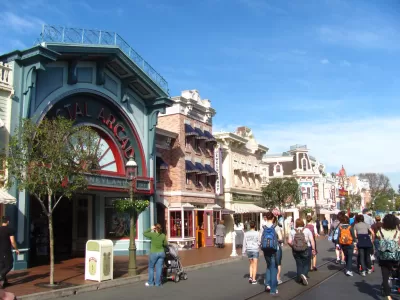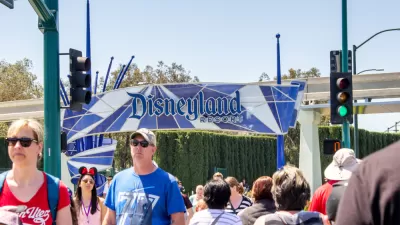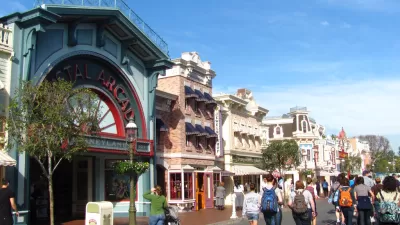The conference of the California chapter of the American Planning Association took place across the street from Disneyland this week. What Disney does for fictional landscapes, planners must do for real landscapes.

“On the one hand, the there's a shocking contrast between the lifelessness of Harbor Bl. and the intrigue of Tomorrow, Fantasy, Adventure (and, of course, California Adventure, which you apparently visit if you don't like the real California but also don't want to leave California).”
“On the other hand, that contrast is likely a feature, not a bug. Disneyland came about precisely at the peak of and, I would argue, because of mid-20th century suburbanization. As the country was becoming deliberately dull and homogenous in the late 1950s, a place of excitement, escape, and, indeed, ersatz urbanism became more marketable. Disneyland promoted suburbanization in order to offer an antidote to suburbanization. The uglier [Anaheim] is, and the less pleasant that walk is, the more exciting those other -lands become.”
“Disneyland is nicer than the real world. People are willing to pay for nice, even for only a few hours. That's because, for much of recent history, in the vast majority of places, the imagination and talent has been privatized, funded, and promoted, and the public realm has, in too many cases, been neglected, starved, and vilified. The public realm doesn't get nearly the sort of attention and investment as even a few dozen acres of private realm.”
FULL STORY: APA Conference: When Planners Wish Upon a Star

Planetizen Federal Action Tracker
A weekly monitor of how Trump’s orders and actions are impacting planners and planning in America.

Canada vs. Kamala: Whose Liberal Housing Platform Comes Out on Top?
As Canada votes for a new Prime Minister, what can America learn from the leading liberal candidate of its neighbor to the north?

The Five Most-Changed American Cities
A ranking of population change, home values, and jobs highlights the nation’s most dynamic and most stagnant regions.

San Diego Adopts First Mobility Master Plan
The plan provides a comprehensive framework for making San Diego’s transportation network more multimodal, accessible, and sustainable.

Housing, Supportive Service Providers Brace for Federal Cuts
Organizations that provide housing assistance are tightening their purse strings and making plans for maintaining operations if federal funding dries up.

Op-Ed: Why an Effective Passenger Rail Network Needs Government Involvement
An outdated rail network that privileges freight won’t be fixed by privatizing Amtrak.
Urban Design for Planners 1: Software Tools
This six-course series explores essential urban design concepts using open source software and equips planners with the tools they need to participate fully in the urban design process.
Planning for Universal Design
Learn the tools for implementing Universal Design in planning regulations.
New York City School Construction Authority
Village of Glen Ellyn
Central Transportation Planning Staff/Boston Region MPO
Institute for Housing and Urban Development Studies (IHS)
City of Grandview
Harvard GSD Executive Education
Regional Transportation Commission of Southern Nevada
Toledo-Lucas County Plan Commissions





























